lies like truth: September 2009 Archives
 I had the privilege of catching an hour or so of mezzo-soprano Stephanie Blythe's masterclass at the San Francisco Conservatory of Music yesterday in between meetings and deadlines. Not only is Blythe one of the most versatile and stunning singers of today, but it also turns out that she's a wonderful pedagogue with a lovely sense of humor.
I had the privilege of catching an hour or so of mezzo-soprano Stephanie Blythe's masterclass at the San Francisco Conservatory of Music yesterday in between meetings and deadlines. Not only is Blythe one of the most versatile and stunning singers of today, but it also turns out that she's a wonderful pedagogue with a lovely sense of humor.I watched Blythe coach three of the Conservatory's young female singers. The two sopranos sang arias from Italian operas (Verdi's Rigoletto and Bellini's I Capuleti ed i Montecchi); the mezzo performed a Mahler art song.
Blythe has an immediate way of connecting with students. She corrected the shoulder-rolling posture of one of the sopranos by talking about the TV show Dancing with the Stars. "I'm addicted to Dancing with the Stars," declared Blythe, before launching into a cautionary tale about the problems of wearing revealing clothing when your posture isn't perfect. (The soprano in question had hunched, forward-rolling shoulders which were made all the more obvious by the fact that she was wearing a strapless black cocktail dress.) "When you sing, you lead with your sternum," Blythe instructed, flowing across the stage in a voluminous black and white floral kimono, black slacks and opened-toed sandals. "My teacher used to say to me, 'you've got big tits; stick 'em out and sing.'"
Besides discovering that Blythe is addicted to trashy TV (she's also a fan of America's Next Top Model) I also learned so much about the art of singing in that short hour. Here are some more of Blythe's pedagogical pointers:
1. Stand in a three-quarter stance rather than face-on to the audience. In this stance you are balanced and no one can push you over. Plus the angle is flattering.
2. Let your hands go. Don't hold them in front of you like you're carrying a loaf of bread.
3. The motion of the sound should always move forward even in quiet passages. Always spin the tone.
4. For every aria you sing, you should sing five art songs. Although it's not possible to make a career singing art song full time, art song is the best way of training the voice and developing communication / acting skills.
5. You don't have to stand stock still by the piano when you give a recital.
6. Acting is connecting to a thought. Follow your instincts, commit to a thought, and move with purpose and direction.
 As I walked out of the press screening of Richard Linklater's excellent new film about Orson Welles and the build-up to his landmark 1937 Mercury Theatre adaptation of Shakespeare's Julius Caesar last night, it struck me that as engrossing as Linklater's film is -- and it is indeed worth seeing for the quality of the performances, the slick storytelling and the shabbily endearing 1930s New York aesthetic -- in one respect it's just like pretty much all of the films that are made these days about the world of the stage: It paints it in a twee and comedic light.
As I walked out of the press screening of Richard Linklater's excellent new film about Orson Welles and the build-up to his landmark 1937 Mercury Theatre adaptation of Shakespeare's Julius Caesar last night, it struck me that as engrossing as Linklater's film is -- and it is indeed worth seeing for the quality of the performances, the slick storytelling and the shabbily endearing 1930s New York aesthetic -- in one respect it's just like pretty much all of the films that are made these days about the world of the stage: It paints it in a twee and comedic light.Where are the new films that treat theatre as a serious dramatic subject? Where is the 21st century's version of Les Enfants du Paradis? It strikes me that films that include the theatre at all in their plotlines these days are mostly historical in context. Even the best of these, such as Linklater's Me and Orson Welles mentioned above or Mike Leigh's Topsy Turvy, look back at the stage as a medium of the past. Rose-tinted nostalgia and heaps of tweeness are often part of the cinematographic package.
Meanwhile, the films that portray theatre in the present day, such as Christopher Guest's Waiting for Guffman, tend to make fun of the stage and the people involved in making theatre -- it's a subject ripe for ridicule rather than serious consideration. I don't have anything against comedy. Let's face it, there's a lot about the theatre that's pretty funny. But it would be great to see a different approach for once. I think there's definitely a niche out there for some enterprising writer / director to create a movie about the theatre that's contemporary and that doesn't prettify, or otherwise condescend to the subject matter.
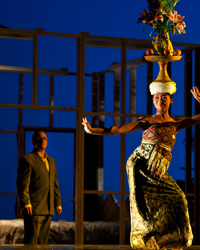
Stewart Wallace's 2008 opera The Bonesetter's Daughter, based on the novel by Amy Tan and first presented at San Francisco Opera, brings traditional Chinese instruments and voices together with western orchestral and operatic traditions in a fairly seamless fashion. Yet the work's greatest allure is the spine-tingling unfamiliarity to western ears of some of the Chinese instrumental passages and the sections featuring traditional Chinese Kunju opera singing, which vividly point to the chasm between the two worlds.
A House in Bali, Evan Ziporyn's new opera based on the experiences of three expat artists living in Bali during the 1930s (the composer Colin McPhee, the painter Walter Spies and cultural anthropologist and author Margaret Mead) which just had its American premiere under the auspices of Cal Performances, seems focused on achieving the same blend versus difference. Once again, the difference wins out. The score sets a western contemporary music group against a gamelan ensemble, in this case, the Bang on a Can All-Stars and Gamelan Salukat. Besides one or two shimmering, quiet passages in which solo players from both groups duet on marimba-like instruments from both traditions, the most memorable passages in the score occur when each group plays separately. When they come together, very often the sound approaches cacophony.
The power of difference and compartmentalization also comes across in the staging. The activity going on on the main part of the stage is set apart from hidden activities going on in box-like secluded rooms at the back of the stage. A movie screen provides a birds-eye view on what's happening behind the compartment walls.
As a result, McPhee's feelings of being an outsider in his beloved Bali surpass the idea that a westerner might become a truly integrated member of a foreign community. So what can we glean from the oil and water landscapes that these opera composers have been creating of late? Is the attempt to truly unite different musical traditions ultimately doomed? Or do these works point to a somewhat heartening social reality: that despite the sway of international travel, free market law and mass corporatization, perhaps the world is not quite as much of a global village as we would like to think?
 The new vocal music media project, VoiceBox, which I host and produce, is ramping up for a January 1 launch on public radio station KALW 91.7 FM. The weekly series, which explores the art of singing and the best of the vocal music scene from the Bay Area and beyond, will also launch as a podcast and web portal.
The new vocal music media project, VoiceBox, which I host and produce, is ramping up for a January 1 launch on public radio station KALW 91.7 FM. The weekly series, which explores the art of singing and the best of the vocal music scene from the Bay Area and beyond, will also launch as a podcast and web portal.At the moment, I'm in the throes of fund-raising for the project. VoiceBox is a fiscally-sponsored project of the media incubator Independent Arts & Media. So all donations to the cause -- which are gratefully accepted and easy to make by clicking here -- are also, happily, tax-deductible.
VoiceBox has received a few nice bits of media coverage so far. Early Music America, San Francisco Classical Voice and Scanning the Dial all covered the project. I would welcome any ideas for themes and artists to feature on the series next year, as well as any thoughts about potential fundraising sources.
To find out more about VoiceBox, click here. To listen to all five of the pilot episodes which ran earlier this summer, click here.
Also, for anyone reading this who lives in the Bay Area: Indy Arts & Media is hosting a big Arts Expo in Golden Gate Park tomorrow from 11am - 6pm. The event will feature stands by many local arts organizations. Worth a visit.
 Although I didn't realize it until intermission when artistic director Patrick Dooley made an announcement, I witnessed a small but significant historical occasion at the Berkeley theatre company Shotgun Players last night: For the first time in its history, the company added a Wednesday night performance. Shows now play from Wednesday to Sunday, instead of Thursday to Sunday.
Although I didn't realize it until intermission when artistic director Patrick Dooley made an announcement, I witnessed a small but significant historical occasion at the Berkeley theatre company Shotgun Players last night: For the first time in its history, the company added a Wednesday night performance. Shows now play from Wednesday to Sunday, instead of Thursday to Sunday.This doesn't sound like a big deal: Companies often extend their runs around here. But one rarely hears about theatre organizations adding extra weekly performances throughout a run in this way. The move seems especially bold during a recession. The house for Marcus Gardley's new play about Rosie the Riveter, This World in a Woman's Hands, was fairly full too. Go Shotgun.
 People who go to recitals around the Bay Area tend to spend a lot of time complaining about the Herbst Theatre. The 928-seater hall (pictured left) has a noble history and is lovely to look at. It was the site of the signing of the United Nations Charter on June 26, 1945. Originally designed as the Veterans Auditorium, the theatre was refurbished and renamed Herbst Theatre in 1977. Eight large beaux-arts murals, created by Frank Brangwyn for the 1915 Panama-Pacific International Exposition, adorn the walls while overhead five chandeliers hang from the blue and gold-leaf ceiling.
People who go to recitals around the Bay Area tend to spend a lot of time complaining about the Herbst Theatre. The 928-seater hall (pictured left) has a noble history and is lovely to look at. It was the site of the signing of the United Nations Charter on June 26, 1945. Originally designed as the Veterans Auditorium, the theatre was refurbished and renamed Herbst Theatre in 1977. Eight large beaux-arts murals, created by Frank Brangwyn for the 1915 Panama-Pacific International Exposition, adorn the walls while overhead five chandeliers hang from the blue and gold-leaf ceiling.But as lovely and important as Herbst is, it's a lousy place to put on a concert. The acoustic is bad, the place always feels empty (as it's usually quite difficult to fill 928 seats for chamber music concerts) and the stage looks shabby owing to the cheap-looking sound dampening "wall" that always acts as a backdrop for performances. The space lacks a bar or cafe and the lobby feels chilly and unwelcoming and has nothing much in the way of seating.
Herbst ends up being the de facto choice for presenters because there really aren't any other viable options in town. Sure, there are plenty of churches, but none of them feel like concert halls and elderly classical music fans don't feel comfortable sitting in pews for long amounts of time. With the possible exception of the performance hall at the De Young Museum in Golden Gate Park (which sounds good and is all state of the art but feels claustrophobic and sparse and is difficult to access without a car in the evening) I'm hard pressed to think of a single other suitable space in which to present chamber music concerts.
I wonder whether some of the auditoriums used for jazz, rock and folk music gigs might fit the bill? I love Yoshi's as a space. The Great American Music Hall might also be a fun (albeit perhaps not sonically terrific or particularly comfortable) place to experience a classical music concert. Or perhaps it's about time that San Francisco invested in a great new recital hall?

It flummoxes and somewhat heartens me that Fox can be such a reactionary media network (at least from a news and commentary perspective) yet still manages to produce some amazingly progressive and engaging programming. My latest obsession is the new fictional comedy series Glee, which follows the fortunes of a bunch of misfit high school students and their teacher as they struggle to take the school's all-singin', all-dancin' glee club to the top.
The pilot and first two episodes of the show have all been snappily written. The performances are smart and funny. I especially like Jane Lynch (a Christopher Guest mockumentary stalwart) as the snarling, self-important trainer of the cheerleading team, Sue Sylvester, and Matthew Morrison's happy-go-lucky turn as Spanish teacher and glee club coach, Will Shuester. The characters are all well-rounded and I like the fact that you can't really predict how they'll grow as the series progresses. I've been surprised on several occasions already about the twists in the characters' reactions to situations. I've found myself becoming unwittingly attracted to characters that initially got on my nerves (eg Jayma Mays' Emma Pillsbury, a cleanliness-obsessed school counselor.) And I even find myself sympathizing with characters who genuinely do make my toes curl, such as Terri Schuester (played by Jessalyn Gilsig) the troubled and irritating wife of the show's hero, Will.
What's best about the series, though, is it's celebration of the performing arts in a grassroots way. Even the jocks and the cheerleaders in the school can give Justin Timberlake and Pink a run for their money. What this communicates is that using your voice and moving your body in time to the rhythm are not -- contrary to what most people think -- activities just for choir geeks and ballet nerds. The musical arrangements by Roger Emerson and Mark Brymer of such cheesy pop hits as "I Want to Sex you Up" by Color Me Badd, Amy Winehouse's "Rehab", Journey's "Don't Stop Believin'" and "Mercy" by Duffy, are without exception, captivating. I'm definitely buying the series album, parts of which are already available on iTunes. You can even by the sheet music for the choral arrangements on the show's website. I hope that the series encourages more high schoolers to get into music and dance
Can't wait until the next episode, which airs tomorrow night, Wednesday, at 9pm. I'll be catching it shortly thereafter via Hulu.
The pilot and first two episodes of the show have all been snappily written. The performances are smart and funny. I especially like Jane Lynch (a Christopher Guest mockumentary stalwart) as the snarling, self-important trainer of the cheerleading team, Sue Sylvester, and Matthew Morrison's happy-go-lucky turn as Spanish teacher and glee club coach, Will Shuester. The characters are all well-rounded and I like the fact that you can't really predict how they'll grow as the series progresses. I've been surprised on several occasions already about the twists in the characters' reactions to situations. I've found myself becoming unwittingly attracted to characters that initially got on my nerves (eg Jayma Mays' Emma Pillsbury, a cleanliness-obsessed school counselor.) And I even find myself sympathizing with characters who genuinely do make my toes curl, such as Terri Schuester (played by Jessalyn Gilsig) the troubled and irritating wife of the show's hero, Will.
What's best about the series, though, is it's celebration of the performing arts in a grassroots way. Even the jocks and the cheerleaders in the school can give Justin Timberlake and Pink a run for their money. What this communicates is that using your voice and moving your body in time to the rhythm are not -- contrary to what most people think -- activities just for choir geeks and ballet nerds. The musical arrangements by Roger Emerson and Mark Brymer of such cheesy pop hits as "I Want to Sex you Up" by Color Me Badd, Amy Winehouse's "Rehab", Journey's "Don't Stop Believin'" and "Mercy" by Duffy, are without exception, captivating. I'm definitely buying the series album, parts of which are already available on iTunes. You can even by the sheet music for the choral arrangements on the show's website. I hope that the series encourages more high schoolers to get into music and dance
Can't wait until the next episode, which airs tomorrow night, Wednesday, at 9pm. I'll be catching it shortly thereafter via Hulu.
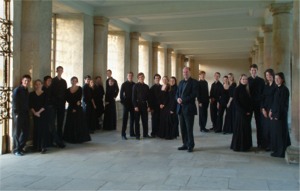
 What happens when a choral ensemble from one country attempts to sing the music of another tradition? Sometimes being an outsider brings a whole new perspective on the culture of a different place and fireworks ensue. Sometimes the effort, though well-intentioned, results in a complete misfire.
What happens when a choral ensemble from one country attempts to sing the music of another tradition? Sometimes being an outsider brings a whole new perspective on the culture of a different place and fireworks ensue. Sometimes the effort, though well-intentioned, results in a complete misfire.I experienced both of these outcomes over the weekend at a pair of choral concerts by two fine choirs, The Choir of Trinity College, Cambridge from the UK and the Bay Area's Clerestory ensemble. Both groups feature terrific singers and perform a fairly wide repertoire. But while Clerestory managed to pull off many of the English works it performed in its concert of music dating from the Middle Ages to the present, Trinity College Choir 's concert of mostly liturgical works fell flat when the group attempted to sing American songs.
The globe-trotting Trinity Choir, one of the best mixed choirs in the UK, is currently on a US west coast tour. The group performed an eclectic mix of music by composers as diverse as Arvo Part, J S Bach, Henry Purcell and Pawel Lukaszewski at San Francisco's Grace Cathedral on Friday night. Music by English composers dominated the evening's lineup and the group brought richness and feeling to all the music in the first half. I was particularly moved by the shimmering performances of Thomas Tallis' "O Nata Lux", Purcell's "Hear my Prayer" and William Byrd's "Civitas Sancti Tui".
But in the second half, Trinity Choir's attempts to sing negro spirituals were pretty laughable. The singers tried their best to loosen up and get into the "hallelujah" spirit for arrangements of "Way Over in Beulah-lan'", "Goin' Home to God" and "Joshua Fought the Battle of Jericho" arranged by Joseph Jennings, Steve Barnett and Jonathan Rathbone respectively. But they were way too stiff and seemed pretty uncomfortable with the music's showy high notes and ecstatic exclamations. No amount of technical perfection helped their cause. I'm not sure what it would take to get these buttoned-up, Cambridge-educated, young singers to access the energy needed to pull off this kind of repertoire. More of an immersion in the spiritual tradition is necessary for sure. As it was, the effect was rather like watching a Monty Python skit.
The Bay Area-based members of Clerestory fared a lot better at the English repertoire in their concert at St Mark's Lutheran Church in San Francisco. The eight-strong all-male ensemble took an unusually democratic approach to programming. Each of the singers simply picked a song that he loved and the group performed the selection. The singer responsible for each selection wrote about the piece in the program, providing some background on the work as well as his own personal interest in and history with the music. Rarely have program notes been so interesting.
I rarely read program notes during a concert, so I tried to figure out from looking at the performers' faces which of the songs each one selected. In some cases, this was clear. There was a particularly rapturous look in one of the performers that gave the game away. Sometimes, though, it was harder to tell. In general, the technical proficiency of the singing sometimes led to a certain flatness of emotional communication. The sound was clean and bright. Each individual voice could be heard in the texture. The blend was generally smooth. But on some occasions, the overall effect was sparse and a little under-emotional. I couldn't tell if any of the singers were actually enjoying certain pieces at all, much less pick out the person for whom the song held particular weight.
Among my own personal favorite works of Clerestory's concert were a little-performed but extremely vivid motet -- "Memorare Christ a 7" by Mattheus Pipelare (c1450 - c1515) -- and Josquin Desprez's haunting "La Deploration sur la Mort de Jean Ockeghem". But I was probably equally swept away by the group's cool, clean approach to pieces by such British composers as John Tavener ("The Lamb"), John Rutter ("Dashing Away with the Smoothing Iron"), Peter Warlock (The Shrouding of the Duchess of Malfi") and Byrd ("Gloria" from the Mass for Five Voices.)
I wonder if Clerestory's success and Trinity's failure suggests that Americans are more steeped in British musical traditions than Brits are in American traditions? I wouldn't be surprised if this were the case -- after all, there are several more centuries of history behind the English choral tradition than the American one. Or is it that English church songs are simply easier to sing than African-American ones?
PS This just in from Clerestory founder (and former Chanticleer member) Jesse Antin which I thought might be of interest -- thanks Jesse for allowing lies like truth to post your comments:
"I've always thought that choral arrangements of negro spirituals are a tough thing to ask of any white choir. We had some success in Chanticleer thanks to [ex-Chanticleer music director] Joe Jennings' inspiration and background, which contributed some integrity to our attempts. Still, even for us there was some self-consciousness. For an English cathedral choir, that much further removed from African American traditions, it might be too much to ask. This taps into two other pet peeves of mine. #1: why do choirs touring internationally try to sing music native to the place they're visiting? This is a terrible and overrated idea. The audience may appreciate the thought or the effort, but they can't have paid to hear a foreign choir sing (possibly butcher) their own music, which they probably hear all the time anyway. Bringing the choir's *own* native music, I can understand. #2: why do choirs (or their directors anyway) insist on adhering to the score note for note? Is it our classical music hang-up? I ask because what the Trinity director should have done -- if he insisted on performing spirituals at all -- is modify or leave out the parts that his choir couldn't do effectively. This is completely within a director's discretion and it makes for a performance with more integrity, not less. The idea of insisting on a rigid adherence to an arrangement of an African American style is particularly ironic."
 The initial feeling that hit me when I walked into the 3A Gallery in the South Park neighborhood of San Francisco, was how picture postcardy the first massive image I came across in Oakland photographer Jonathan Ball's Great Wall of China exhibition looked to my untrained eyes.
The initial feeling that hit me when I walked into the 3A Gallery in the South Park neighborhood of San Francisco, was how picture postcardy the first massive image I came across in Oakland photographer Jonathan Ball's Great Wall of China exhibition looked to my untrained eyes.The panoramic photograph in question depicts a verdant, bumpy landscape of peaks and valleys with the famous wall snaking its way across the terrain. It's obviously a beautifully-composed picture, but there's nothing particularly unusual about it. I've never been to China but I feel like I've seen this image or one very like it hundreds of times before.
But then when one starts to read the backstory behind the image, it comes to life in a new way. All the photographs in the exhibition depict sites of historical significance, where important Manchu and Mongol raids occurred in the 15th - 17th centuries. The images capture the points of view of the defenders or raiders involved in the skirmishes and were taken on the anniversaries of the raids, as close as possible to the time of day when the battles took place.
The exhibition is a collaboration between Ball and Great Wall specialist David Spindler. Spindler is an American citizen and one of the world's leading Great Wall specialists. He lives in China and was the subject of a New Yorker profile a couple of years ago by Peter Hessler.
The stories of the raids can be read in an accompanying pamphlet. They provide a small but vivid insight into the raids which took place centuries ago. It's hard to imagine the horrors that occurred at the sites depicted in Ball's photographs. The images are so open, spacious and bright. In one picture, a shepherd herds a woolly blur of sheep; in another castle battlements tower benignly over a sun-lit courtyard. In a third, light snow sparkles on a rugged hillside. The fun of this exhibition is therefore very much in the contrast between the photographs and the unflinching-dry reportage of Spindler's text.
The significance of taking these photographs on the anniversary of the raids doesn't quite come across as you walk through the exhibition. It seems like a sense of chronology is important to Ball and Spindler. They even took care to bear witness to the actual time of day when the raids took place. as such, I would have liked to know more about the circumstances under which the photographs were taken -- perhaps a description of why each site was chosen, what the hike to the site was like, and what time of day the photograph was taken. In any case, I left the gallery feeling like I'd stepped into a different world for a couple of hours.
 Berkeley isn't known for its fashion prowess. Most of the residents of this sunny, west coast university town schlump about in ill-fitting jeans or baggy shorts, flip-flops and old T-shirts. To dress up in Berkeley is to put on a hoodie.
Berkeley isn't known for its fashion prowess. Most of the residents of this sunny, west coast university town schlump about in ill-fitting jeans or baggy shorts, flip-flops and old T-shirts. To dress up in Berkeley is to put on a hoodie.Last night was therefore completely out of the ordinary, as hundreds of people rocked up to Berkeley Repertory Theatre dressed to the elevens (forget the nines and even tens) for opening night of the world premiere of American Idiot, a new rock musical directed by Michael Mayer based on the songs of punk band Green Day.
It was quite a scene. There were girls in figure-hugging, hot pink leather dresses and four-inch stiletto heels and plenty of spiky-haired guys wearing eye-liner, tight jeans, jackets and hastily-knotted ties. In the midst of it all was Berkeley Rep's formidable artistic director, Tony Taccone, looking like a Green Day groupie in a punkie black ensemble offset by a gamine red, shiny, skinny tie. Only his chipmunk grin and slightly sheepish air set him apart from the too-cool-for-school crowd hanging out outside the theatre before curtain.
I'm not surprised that Taccone's face registered both pride and a measure of embarrassment -- I reckon the event was quite unlike anything that the city of Berkeley has seen in quite some time, both from a commercial and creative perspective. The paparazzi was out in full force, snapping the Green Day boys at all opportunities. Corporate sponsorship e.g. in the form of huge Levis' signs projected on the sides of buildings, was rife. The post-show party didn't remotely resemble the kind of affair one usually sees in the non-profit theatre world, namely a few white-haired people chatting for half an hour over a sweaty cheese plate and plastic tumblers of cheap red wine. The "heroine chic" decor was inspired by the show. There was tons of classy food. One of Berkeley Rep's stages had been take over by a DJ who span punk and garage rock music before a mosh-pit-filled huddle of sweaty bodies. There were swag bags with stuff people actually might want in them (such as Green Day's new album on CD), old-fashioned pinball machines and a fussball table. You could even get a free haircut and have your photo taken as if standing on the show's set.
The soiree basically smacked of two things: 1. A desire to impress, and 2. A desire to impress enough to get American Idiot to Broadway.
I don't doubt that the man in the skinny red tie knows what he's doing. Following the success on Broadway of Passing Strange and various other New York-bound missives sent by Berkeley Rep in recent years, Taccone appears to have his eye on the ultimate prize: a commercially triumphant musical of Spring Awakening proportions. He looks like he wants to be the Des McAnuff of Northern California.
I didn't personally like Spring Awakening -- found it very derivative and the songs didn't inspire me at all. American Idiot, though cliche-ridden and lacking in a storyline, has one great advantage over director Michael Mayer's previous Broadway hit: the soundtrack. Green Day's music hits you in the gut and tears a big hole in your spleen. The kids'll really go for it in New York, I think. It won't be too long before that skinny red tie gets a second airing on the other side of the country.
 Every few months, myself, another Bay Area theatre critic, two directors, an actor and a producer get together to host what we call a "theatre salon" -- an evening involving anything between 12 and 50 people, food, wine and conversation about a specific topic to do with the performing arts. Past themes have included the San Francisco Fringe Festival, theatre-makers' relationship with audiences and theatre and the (ailing) economy.
Every few months, myself, another Bay Area theatre critic, two directors, an actor and a producer get together to host what we call a "theatre salon" -- an evening involving anything between 12 and 50 people, food, wine and conversation about a specific topic to do with the performing arts. Past themes have included the San Francisco Fringe Festival, theatre-makers' relationship with audiences and theatre and the (ailing) economy.This time around we decided to spend an evening with a smallish group of colleagues (some new to the salon concept and some old hands) to talk about theme of elitism. Our original intention was to discuss whether a fear of seeming too elitist and not being "accessible" and "inclusive" enough makes artists fearful of actually discussing their work and their aesthetics.
But we never really ended up talking about that topic. Instead, we got mired in a semantic discussion about the definition of elitism and other related words such as "artist" versus "craftsman".
I usually have no trouble contributing to our salon discussions. But for some reason I found myself completely tongue-tied on Monday night. I kept thinking I had something important or at least valid to say, but then the moment would pass and I'd find myself looking in on myself wondering why I ever thought that my thought would be worth articulating.
The topic of elitism completely confounded me. I walked into the room thinking that I had a clear stand on the subject at least from a personal perspective as a critic: Namely, I try to approach every production I see in a similarly open and hopefully intelligent way. I'm not afraid to bring Heidegger to bear in an essay about Point Break Live or Dangerous Housewives into a discussion about Miss Julie if doing so makes sense. I imagine my readers to be interested in theatre and reasonably well-informed. At the same time, I don't engage in dry academic discourse.
But as the evening progressed I got quite confused and knotted up in the discussion. Pretty soon, I couldn't get much of a footing at all. I think I uttered about two sentences the entire evening.
That being said, I relished the discussion going on around me as frustrating as it was at times. My colleague Mark put the feeling very eloquently in an email he sent out to our small group last night: "It seems that ultimately we must be comfortable with a certain amount of unruliness to the Salon discussions, and accept that the most interesting stuff, if it gets said at all, will more often then not get said in wee groups at the end of the night, or the next day, or a week later. In other words, the Salons are an unwieldily leaping off point, a party-ish beginning, to a longer, ongoing discussion of the theater." Here, here.

Following the debacle that was the San Francisco Fringe "Sneak Peek" preview soiree a few weeks ago, I didn't have high hopes for my day of Fringeing on Sunday. I had six shows on my schedule starting at 1pm. I figured that the only way I could get through it all was to medicate heavily between each performance.
So I was unimaginably thrilled to discover that not only did I not need booze to soften each theatrical blow, but that this was probably the best day of Fringeing I've experienced to date.
I didn't manage to get to all six shows -- Performers Under Stress' riff on Shakespeare's The Tempest, tempestuous(ness), went on for an hour and a half, which meant I had to skip Hell: The Musical. But with the exception of one production which was very, very, very bad, the other four I saw were rather delightful. And a couple of them even approached art in places. Here's a quick rundown of what I saw:
1pm, Exit Theatre -- Jesus In Montana: I felt a bit preached to by Barry Smith's solo show about the spiritually gullible. Nevertheless, the performer/writer puts on a slick and engaging performance full of humor and heart. Next time someone mentions the Baha'i faith in conversation, I will be better equipped to follow their train of thought.
2.30pm, The Garage @ 975 Howard -- tempestuous(ness): PUS' take on The Tempest might be rough around the edges. But the ensemble cast attacks Scott Baker's quite cleverly composed Wicked-meets-Rosencrantz-and-Guildenstern-are-Dead-like script with such gusto that it's hard not to fall in love with both the actors and the ideas. I could have done without the limp "five-minute-Tempest" at the end of the performance. But I'll listen to Shakespeare's sonnets intoned by a middle-aged actor with a passion that belies his speech impediment any day.
5.30pm, Exit Theatre -- The Tao of Everest: Obviously the lack of oxygen at the top of Mount Everest has killed a few of British mountaineer Ian Woodall's brain cells. What on earth makes him think he can put on a play? His self-adulatory presentation (featuring slides, badly edited pop music interludes and lots of arm flailing and pontification) about the Challenges of Reaching the Top is one of the most embarrassingly turgid experiences I've ever had in a theatre. The climber also completely fails to acknowledge the controversy surrounding his career, which has been well-documented in the UK press. I blogged about the decision to include Woodall's show in this years Fringe lineup here.
7pm, The Climate Theater -- Legs and All: Sparks fly when the brilliant physical comedienne Summer Shapiro (pictured) teams up with equally-talented clown Peter Musante for a bittersweet and hilarious show about the delicate negotiations that go on between two people embarking upon a romantic relationship. Brandi Brandes' live percussion playing adds an extra layer of quirk to the pair's lively and often surreal physical escapades.
8.30pm, The Climate Theater -- Show No Show: Climate (and former Cirque du Soleil) stalwart John Gilkey plays an over-the-top comedy club-type MC in a performance that is part stand-up-comedy situation comedy and part off-the-wall farce. Joined by his downbeat colleagues in clowning Donny Divanian and Alec Jones-Trujillo, Gilkey weaves a face-achingly funny tale of three comedians striving to get it right.
The San Francisco Fringe Festival continues through September 20. Tickets are cheap! Find out more here.
 Why is it that no one thinks twice of adapting classic plays to suit certain ensembles and aesthetic predilections in the theatre, whereas the idea of creating new versions of canonical works from classical music repertoire is often frowned upon?
Why is it that no one thinks twice of adapting classic plays to suit certain ensembles and aesthetic predilections in the theatre, whereas the idea of creating new versions of canonical works from classical music repertoire is often frowned upon?On Saturday, I attended a concert given by the ever-innovative New Century Chamber Orchestra (music director Nadja Salerno-Sonnenberg, pictured left) which featured a program of re-envisioned takes for string orchestra on two works by J S Bach ("Chaconne" from Partita No. 2 for solo violin arranged by Mark Starr and Concerto for Violin in D minor transcribed by Robert Reitz from the draft of a harpsichord concerto written in about 1738) and Clarice Assad's arrangement of Mussorgsky's Pictures at a Exhibition for string orchestra, piano and a battalion of percussion instruments.
The friend I brought to the performance with me is wild about violinist Rachel Podger's performance of the "Chaconne". "It's such a gobsmacking piece, why would anyone bother adapting it for orchestra?" he said, as we stood in line at intermission for drinks.
Why bother indeed?
While I wasn't completely convinced by the Bach arrangements in the concert, which sounded stormily thick and full but lacked the lightness of touch that I love so much about Bach's music, I valued all three works on the program for the "strangeness" factor. The "Chaconne" and Pictures at an Exhibition are both so well known that one can get stuck in one way of listening to them. Assad's interpretation of Mussorgsky in particular helped me to hear the work in a completely new way -- one that reminds us that Ravel's version is simply a riff on an existing piece, not the definitive take.
I particularly loved the viola solo in "The Old Castle". Anna Kruger's playing was at once mournful and mystical. And the use of percussion -- brought to life by Galen Lemmon -- gave some of the movements, and the playful ones especially, an energy and ebullience that stretched beyond Ravel's capabilities.
Skillful adaptations of canonical works need not always be viewed with derision or as interesting curios. Arrangement has been part of the language of music for thousands of years. In the pop world it's standard. It should also be that way in the classical landscape.
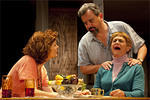 The close-knittedness of the Bay Area performing arts community (and indeed of any community worth its salt) is a constant source of delight and fascination to me.
The close-knittedness of the Bay Area performing arts community (and indeed of any community worth its salt) is a constant source of delight and fascination to me.Yesterday evening, while at the inaugural festivities for Z Space Theatre Company's new home at Theatre Artaud in San Francisco, I was reminded of the oddball pleasures of community when I joined a cluster of local theatre people mid-conversation. We were a group of four, myself included. I knew two of the people in our little group and the other person was a stranger to me, though he looked familiar. (Most theatre people look familiar to me around here -- I've probably seen them on stage at some point over the last ten years but often can't quite place their faces.)
Anyway, the first thing I heard when I joined the cluster was the guy whom I didn't know, say: "Did you read Chloe Veltman's review of August: Osage County? You should have seen the subheadline -- 'So what if August: Osage county won a Tony? It's still boring and bloated.' Hilarious. I thought..." Before he could get any further, the friend who was standing to my right jumped in with one of the most overenthusiastic introductions I've ever witnessed: "M---, This is Chloe Veltman!" We shook hands. M and I both turned scarlet. Everyone laughed. It was a great night.
 A few people have written to me this morning both publicly via ArtsJournal and privately via my email address in response to the blog post I wrote yesterday about the upcoming National Arts Journalism Summit in Los Angeles.
A few people have written to me this morning both publicly via ArtsJournal and privately via my email address in response to the blog post I wrote yesterday about the upcoming National Arts Journalism Summit in Los Angeles.A couple of commentators brought up some worthwhile criticisms of the concept which I would like to highlight and reply to. Here is the first:
"Only four hours for a "summit on journalism"? Seems to me a rather paltry amount of time to spend on such an important subject, and most of it is going to be taken up by speeches and presentations. They can talk about participating through text messaging or Twitter, but it seems a poor way to learn, reason and then offer insights and ideas about a complicated subject. But have at it. Perhaps it will dawn on people that superficial thinking is the problem."
And here is the second:
"Four hours is not long enough, nor is the 10-15 minutes each of the five finalists gets to make their presentations. I also find the secrecy a bit overdramatic. The judges should be named and identified. Mr. McLelland said that 27 of the submissions were agreed by the judges to be strong. Why not at least identify those 27 strong ideas and let's have a real dialogue on how we can forge a future for arts journalists. Why travel to participate in a 4 hour forum when you can do it from the comfort of your office?"
The criticisms that these commentators make about the summit seem reasonable. Four hours isn't a long time. And now that commentator B mentions it, listing the 27 top projects considered for the summit on the website in advance of the live event might be a lovely way to generate excitement ahead of October 2 and make more of the people who contributed projects feel like their efforts were well received. Perhaps the organizers might consider doing this in the coming days?
On the other hand, it seems rather strange for people to start denigrating the summit before it even takes place. This is a first-of-its-kind event. We should be supporting and looking forward to its birth, not tearing it down in utero. Criticism will no doubt play a valuable role when the event is over and we can evaluate its success. But right now, the negativity comes across as rather hollow.
 A few reasons why the upcoming National Arts Journalism Summit which is taking place on October 2 at the University of California Los Angeles has me stoked:
A few reasons why the upcoming National Arts Journalism Summit which is taking place on October 2 at the University of California Los Angeles has me stoked:1. It's about time that arts journalists from around the world got together to figure out how to make cultural coverage viable from a business perspective for the future. As old media struggles to stay afloat and new media struggles to find its financial footing in a tough economic climate, the summit will provide an array of concepts aimed at promoting sustainability.
2. The summit is being streamed live from the summit website and will also be archived, meaning that people can tune in from all over the globe on the day of the event or afterwards. People can also participate in the discussion remotely on October 2 via text message or Twitter.
3. Attending the event, as I hope to do, will provide arts journalists with a wonderful opportunity to mingle and exchange ideas.
4. The summit is unlikely to come up with black and white "answers" in response to the complex challenges of finding models to secure the future of arts journalism. But it will hopefully get people asking the right questions about potential models going forward.
5. As someone who put forward a project for inclusion in the summit (though I sadly didn't make the final cut) I'm personally very excited to find out about a range of projects from across diverse arts areas. The producers of the event have not revealed the names of the five main selected presenters for the summit, though the presenters themselves are already in the know. The revelation of the selected projects on the day of the event itself will no doubt add a little frisson of expectation and excitement to the proceedings.
 Whenever a baby boomer waxes lyrical about how great the 1960s were, and in particular, how great the Woodstock Festival was, I tend to switch off. But Ang Lee's new film about the events leading up to the famous festival, Taking Woodstock, actually makes me wish I'd been around in 1969.
Whenever a baby boomer waxes lyrical about how great the 1960s were, and in particular, how great the Woodstock Festival was, I tend to switch off. But Ang Lee's new film about the events leading up to the famous festival, Taking Woodstock, actually makes me wish I'd been around in 1969.The festival, which attracted some 500,000 concert goers to hear al fresco performances by the likes of Jimi Hendrix, Ravi Shankar, Joan Baez, Janis Joplin and Jefferson Airplane, took place on a 600-acre dairy farm near the hamlet of White Lake in the town of Bethel, New York, from August 15 to August 18, 1969.
What's great about this understated film is that it completely ignores the obvious. We never get to see and hear the performers do their thing -- Lee uses neither documentary footage nor fictional reconstructions with actors pretending to be 1960s rock stars. The closest we come is a long-distance shot of the stage viewed from the outermost edges of the farm. The stage looks like a tiny white speck of light in a field of swarming black insects.
Instead of watching rock stars and groupies interact, what we get get is a frank, sweet and utterly unromanticized view of what it took to put on one of the most legendary rock events in western cultural history.
Lee tells the story through the eyes of Elliot Tiber (played by a sweetly gauche Demetri Martin) the nebbishe twenty-something son of a couple of down-on-their-luck motel owners from the old world. As the head of the local chamber of commerce, Tiber held the only musical festival permit in Bethel, New York, thus enabling the festival to occur.
Over the course of the film, we see the characters deal with the most prosaic of issues. Discussions about permits and portaloos are hardly the stuff of Hollywood reconstructions of seminal historical events. Yet James Schamus' tongue-in-cheek screenplay and engaging performances by the cast, which includes Imelda Staunton as Elliot's hard-nosed mother and Liev Schreiber as a transsexual security guard, make the everyday details dance before our eyes like fireflies around stadium floodlights.
As a result, Woodstock ends up coming to life in a completely vivid and human way.
 It's well known that here in the Bay Area, people have a habit of taking political correctness too far.
It's well known that here in the Bay Area, people have a habit of taking political correctness too far.I was gratingly reminded of this fact a few days ago during a singing rehearsal. I am part of a group of singers that is preparing to perform a bunch of a cappella songs for the patients on the cancer wards of the University of California San Francisco Medical Campus. At the inaugural rehearsal last week, we were working on a trio of new arrangements of old folk songs, one of which was about a mother scolding her daughter for not behaving herself. The song mentioned the word "gypsy" a couple of times in a vaguely derogatory fashion. Almost everyone in the room, except me and one other person who seemed in two minds about the issue, thought we should excise the word "gypsy" from the song lest it cause offense to our audience.
I was instantly appalled at the suggestion. On the one hand I understand that we are supposed to perform a therapeutic function by singing at the hospital and want to uplift and soothe audiences rather than anger or upset them.
On the other hand, changing the lyrics of a song on the grounds of political correctness seems ridiculous to me. The song isn't meant to reflect modern sensibilities. And surely audiences will not think that we as performers have something against Romany people. To replace "gypsy" -- the use of which is pretty mild in the song -- with something else seems pedantic, arcane and completely lacking in any kind of artistic sensibility, not to mention showing disrespect for the integrity of the composer's work.
When the motion was tabled, I guffawed. "How about this for an idea," I suggested, laying on the sarcasm a bit thick. "Let's just say a loud 'beep' every time the word "gypsy" comes up in the song. Just like on NPR when someone says "fuck." That'll do the trick, won't it?"
My idea wasn't met with wild enthusiasm. To be honest, I think it went over most of the singers' heads.
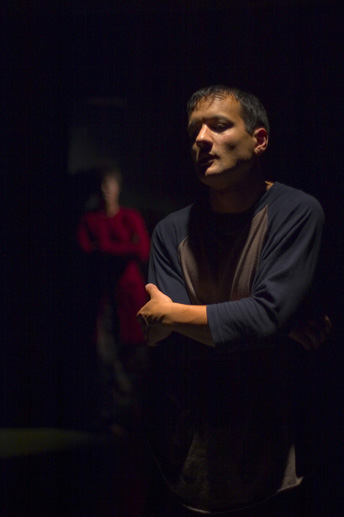 One of the signs of a good actor is that they can hold your attention even when the play they are performing in doesn't. There are a few performers in the Bay Area that truly have this uncanny ability -- so often dubbed "presence". The San Francisco actor Sean San Jose walks among them.
One of the signs of a good actor is that they can hold your attention even when the play they are performing in doesn't. There are a few performers in the Bay Area that truly have this uncanny ability -- so often dubbed "presence". The San Francisco actor Sean San Jose walks among them.San Jose, an actor of Filipino and Puerto Rican background, is most closely associated with the Intersection for the Arts organization. He's not the most versatile actor I've ever seen on stage. He's best at playing tortured heroes with hearts of gold but serious chips on their shoulders. The less even-keeled they are, the better.
In Thick Description's current production of Octavio Solis' dream-like domestic drama set in Texas El Otro, San Jose is therefore truly in his element.
The play itself is problematic. The play takes off like an early Tarantino movie, with San Jose, playing a miscreant father and husband, Guadalupe, takes his teenage daughter, Romy, and his wife's new husband, Ben, on a wild goose chase into the wilderness ostensibly to locate the whereabouts of a gift that he wants to give to his daughter. The quirky buddy-movie-cum-stage-drama plot engages us in the first half but spirals of kilter in the second. I, for one, got lost in the playwright's esoteric dream sequences. I didn't really understand what was going on in the second act or why the characters behaved the way they did.
Nevertheless, I couldn't keep my eyes of San Jose, who behaved in such a compellingly unhinged fashion throughout, that I never knew what he would do next on stage. His performance is carefully controlled yet full of off-beat energy throughout. His lightning quick changes between playing the tender father, joking around with his daughter and tearing into her viciously are the sort of thing that makes you wake up in the middle of the night wondering where your childhood has gone. He makes Solis' anti-hero full-blooded and likable, as much of as bastard as the character is.
The Bay Area is lucky to have San Jose. And I'm only waxing lyrical this morning about his acting abilities -- he is also a formidable arts activist, producer and all-round mensch.
 Nearly every day brings news of another arts organization in financial straits. The latest casualty on the Bay Area performance scene is the Willows Theatre Company. The Concord and Martinez-based company, which has been producing well-trodden, though lively productions in the Bay Area for more than 30 years, has announced that it is facing a financial crisis that may force it to shut down its main-stage facility in Concord and a cabaret in Martinez unless the theater can raise $350,000 by November 1.
Nearly every day brings news of another arts organization in financial straits. The latest casualty on the Bay Area performance scene is the Willows Theatre Company. The Concord and Martinez-based company, which has been producing well-trodden, though lively productions in the Bay Area for more than 30 years, has announced that it is facing a financial crisis that may force it to shut down its main-stage facility in Concord and a cabaret in Martinez unless the theater can raise $350,000 by November 1.It's an old story. And a troubling one. The theatre has been struggling to achieve a balanced budget for more than a year, according to Charles Lewis, board president, and Richard Elliott, artistic director. "We've cut staff, sharply reduced expenses and stretched every scarce dollar, but clearly it is not enough. Any further cuts could put us out of business for good. Clearly, we need help," the duo stated in a press release.
The company is currently presenting productions of Hair and Spelling Bee.
The news doesn't leave me in a very positive frame of mind. Let's hope we don't have to weep for this willow. I feel like quoting a poem by David Harris:
Willow, willow
soft swinging low head
sadness brings night tears
to your breast.
Singing of a night wing
circles in the sky
down in the darkness
a life begins to die.
Willow, willow
no answer to give
sunlight brings bright
eyes exploring where you live.
Songs of happy voices
whisper to the breeze
but no one see the tragedy
that lies beneath the leaves.
Willow, willow
watching the world go by
evening breathes a stillness
near the close of the day.
Cries of distant shadows
and shriek of diving claws
hissing into silence
that will soon engulf them all.
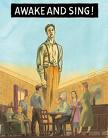 Is it enough to stage a play because it seems socially or politically expedient to do so? Or should the fact that a particular drama reflects the times we live in be just part of the rationale behind mounting a production? All too often, it seems to me, producers and directors make programming decisions based solely on this criteria with little consideration for other equally important factors such as whether the play really suits their company's mission, mandate and/or aesthetic approach.
Is it enough to stage a play because it seems socially or politically expedient to do so? Or should the fact that a particular drama reflects the times we live in be just part of the rationale behind mounting a production? All too often, it seems to me, producers and directors make programming decisions based solely on this criteria with little consideration for other equally important factors such as whether the play really suits their company's mission, mandate and/or aesthetic approach.As a result, audiences are fed a lot of half-baked classics, put on simply because the playwright's anti-war sentiments, commentary on race relations, representation of transgender politics.
At yesterday evening's performance of Clifford Odets' 1934 drama, Awake and Sing!, however, I was reminded that social and political prescience can make for a very effective night out at the theatre. But it has to be married to great acting, a powerful mise-en-scene and mounted with an eye to the mission and audience of the company in question in order to truly succeed.
Awake and Sing! is pretty clichéd and hackneyed at this point. It's themes (the breakdown of the American Dream, the rise of anti-capitalist thinking, the dissolution of the family unit, the generation gap, sexual politics etc) and characters (the domineering mother, the milquetoast father, the smart-talking card shark, the upstanding youth, the grandfather from the shtetl etc) have been seen on American stages many times before Odets came along and many, many times since. But Odets has a wonderful way of developing his characters to their full. When brought to life by Aurora Theatre's crack cast, they dance with humanity. We can't help but feel drawn in to their lives as melodramatic as they seem. Couple the strong performances with Joy Carlin's even-keeled and taut direction, and the play keeps us engrossed thoughout.
Awake and Sing! is also a great choice for Aurora. The play suits the theatre's intimate, deep-cut apron performance space. It also tells a story to which many of the company's audience members can relate. The cast of characters skews on the older side, as does the Aurora crowd at this point. Some of them probably remember growing up around the time that the play is set.
As a result, Odets' play puts across its political and social messages with expediency. But we never feel like we're being bashed over the head with morality. The reasons for staging the play are clear. But they never supersede the experience of engaging with it at the artistic level.
 It's funny, and -- frankly -- depressing, how nothingy little words or expressions creep into everyday speech until they become as rampant as swine flu. We often don't realize when we use the words "like" or "you know" 15 times in a sentence. We get lazy with the way we talk. Is this a relatively recent by-product of our lackadaisical culture or something that's been going on for centuries? And if the latter, I wonder what the Renaissance equivalent for "you know" was? "prithee" perhaps? Or maybe "forsooth"??
It's funny, and -- frankly -- depressing, how nothingy little words or expressions creep into everyday speech until they become as rampant as swine flu. We often don't realize when we use the words "like" or "you know" 15 times in a sentence. We get lazy with the way we talk. Is this a relatively recent by-product of our lackadaisical culture or something that's been going on for centuries? And if the latter, I wonder what the Renaissance equivalent for "you know" was? "prithee" perhaps? Or maybe "forsooth"??A new word has been appearing in the everyday lexicon of quite a few people I know in the Bay Area. It's becoming so prevalent in the culture out here that I thought I should take a moment to point it out. The word in question is: "Really?" It sounds innocuous enough but it's got a boa constrictor hold on the way Californians speak these days.
In the usage of "really" that I'm referring to, the word is always accompanied by a question mark. It's used when people find someone's behavior strange, can't believe something happening or otherwise feel like questioning the world around them. Instead of articulating how strange / incredible something is by describing that something in more detail or their feelings about it, they use "Really?" as a sort of shorthand for incredulity. The word is usually accompanied by a look of perplexity such as a furrowed brow. The second syllable is usually intoned higher than the first.
Although used in more specific circumstances than such common speech ticks as "like" and "you know", "Really?" is, at least to my ear, really, really, lazy. And it's driving me bonkers.
